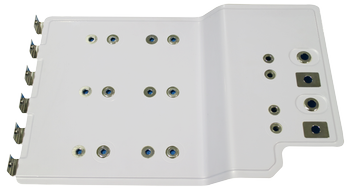Busbars
Modern power electronic converters designs use IGBT transistor modules operating at high frequency. During their switching at the terminals, overvoltage may occur, the main cause of which is the parasitic inductance of the converter internal connections. The rapid changes in large amounts of current flowing through these internal connections are now between 1 and 2.5 kA/μs, and induce an overvoltage at the transistor terminals which it must withstand in a blocking state.
Overvoltage occurring during the converter working has a negative impact on its operation and are, i.a. source of electromagnetic interference and affect the quality of the waveforms obtained at the converter output or, in extreme cases, may damage the IGBT modules.
The inductance of parasitic connections cannot be completely eliminated, however, they can be lowered by the use of low-inductive busbar connections.
Busbar low-induction connections are made of two or more electrically conductive layers, separated by a dielectric layer from each other. A favourable aspect of the use of low-induction laminated busbar connections is the cost reduction, associated with formation the internal converter connections, by improving the device assembly (shortening the assembly time, high repeatability and elimination of errors) and the elimination or reduction of additional capacitors to suppress commutation overvoltage (Snubber cap).
Busbar solutions are successfully used in such areas as: rail transport, power systems, renewable energy sources (wind turbines), telecommunications, industrial power supplies, and the military.


